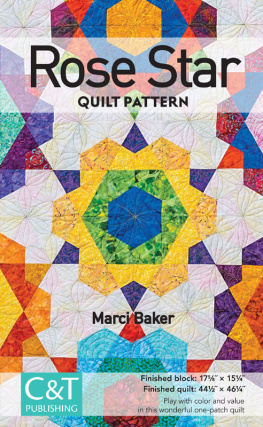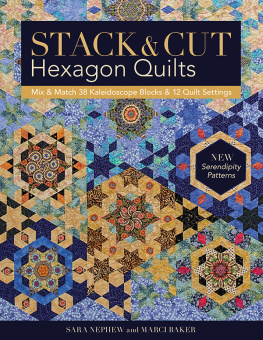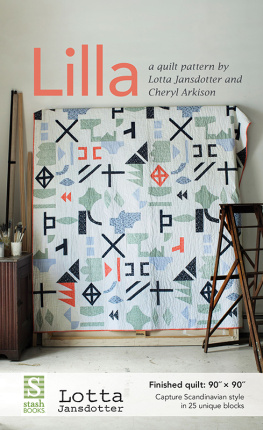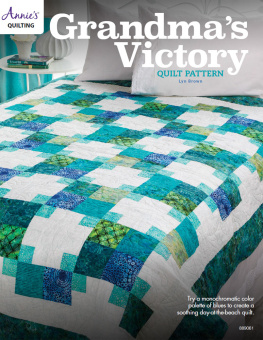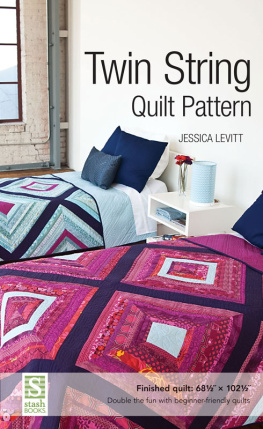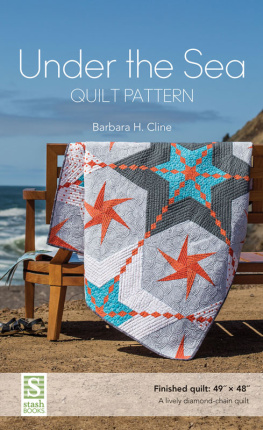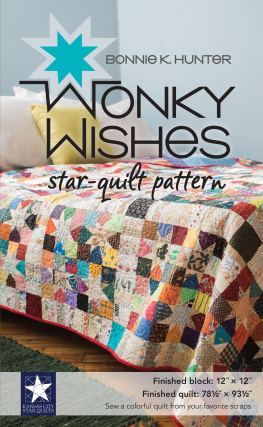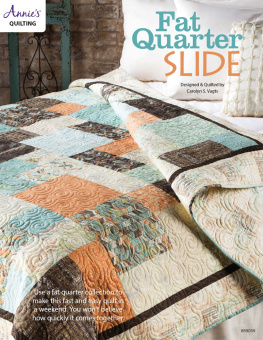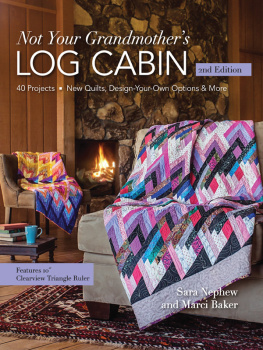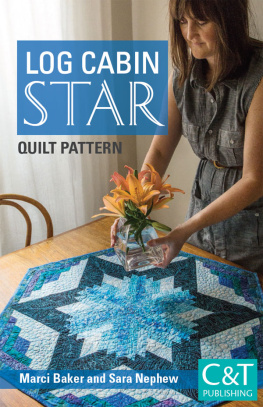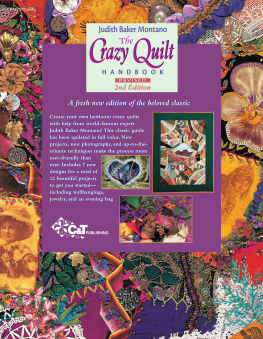Publisher: Amy Marson
Creative Director: Gailen Runge
Editor: Liz Aneloski
Technical Editors: Priscilla Read and Alison M. Schmidt
Design Direction: Kristy Zacharias
Cover/Book Designer: April Mostek
Page Layout Artist: Casey Dukes
Production Coordinator/Illustrator: Tim Manibusan
Production Editors: Alice Mace Nakanishi and Jennifer Warren
Style photography: Page + Pixel
Studio photography: Diane Pedersen, unless otherwise noted
Published by C&T Publishing, Inc., P.O. Box 1456, Lafayette, CA 94549
Rose Star
Finished quilt: 44 46 Finished block: 17 15
This classic quilt design (see Note, next page) creates flowers blooming and stars shining across the landscape of the quilt. Depending on how the values are placed, different effects can happen, including portions appearing to be transparent. All of this is accomplished with one simple shape, hence the term one-patch. The block is fun to make especially with the easy, foolproof method of set-ins.
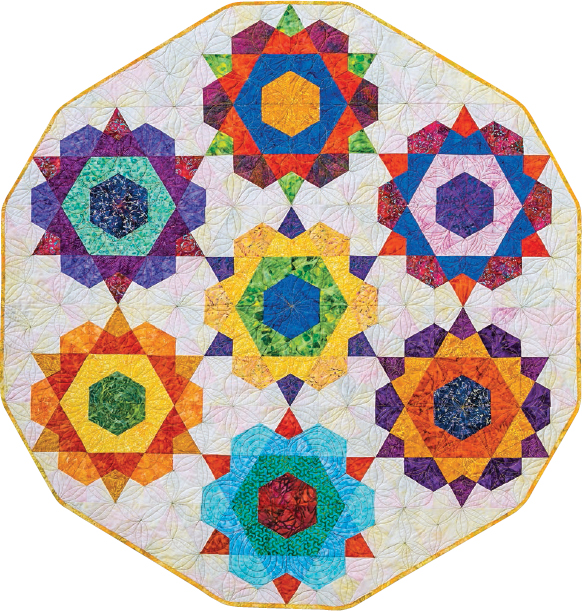
Intro
This illustrated guide will walk you through making this quilt, using a foolproof method for chain piecing set-in seams. Because this is a different type of technique, I recommend trying it as you read through the steps. The process will make more sense and you will see how easy it is. The one-patch teardrops are made using strip-piecing techniques with 2 strips that can be precut.
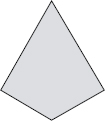
Teardrop
NOTE
The Rose Star One Patch block is listed in Barbara Brackmans Encyclopedia of Pieced Quilt Patterns. The block has been published under several names: Rose Star One Patch (Laura Wheeler, Old Chelsea Station Needlecraft Service, ca. 1935) Canadian Conventional Star (Ruth McKendry. Quilts and Other Bedcoverings in the Canadian Tradition. Van Nostrand Reinhold, 1979) Colonial Flower Garden and Hexagons (Ruth McKendry, L. K. Meeker. Quilt Patterns for the Collector. Portland, Oregon: Self-published, 1979).
60 Ruler
The tool I recommend for making this shape is either the Clearview Triangle Super 60 or Clearview Triangle 60 Acrylic Rulers (any size: 6, 8, 10, or 12; from C&T Publishing). The Super 60 is the ideal one to use because it is the shape of the teardrop and allows the cuts to be made easily. Of the triangle rulers, the smaller ones fit the size of the shape better. Two other tools, Corner Cut 602-in-1 Sewing Tool and On the DotRepositionable Vinyl Ruler Markers (both from C&T Publishing), are also recommended to make the process easier. For more information, see Cutting Teardrops.
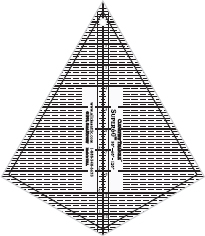
Caution:If you use another manufacturers 60 ruler, especially one with a flat top, youll need to adjust which ruler line is used. An alternate method is to use a traditional template to cut the teardrops.

Piecing
Because piecing this one shape together requires Y-seams or set-in seams, it is quite often made using the English paper-piecing method. It makes a great take-along hand project. However, I have developed a simple, foolproof machine-sewn method for Y-seams that are chain pieced. This is done in conjunction with strip piecing to make this project accessible and successful for a confident beginner up to a more advanced quilter. I know you will enjoy making this design while finding out how easy Y-seams can be!
Fabric Selection
These quilts lend themselves to being scrappy. The value (how light, medium, or dark each fabric is relative to the others around it) makes such a difference in the final look of each Rose Star block. Here are the parts of the block.
A: Center hexagon
B: Ring around center
C: Base of star points
D: Star points
E: Flower petals behind star
Background
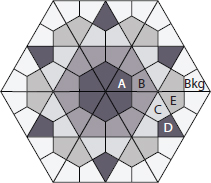
Rose Star block
Here are several fabric placement variations.
Rose design: To emphasize the rose design, select values for D and E that are close in value and color. Have this be very distinct from C.
Star design: To emphasize the star design, select values for C and D that are close in color/value and distinct from E. To make the star even stronger, have B similar in value and/or color to C and D.
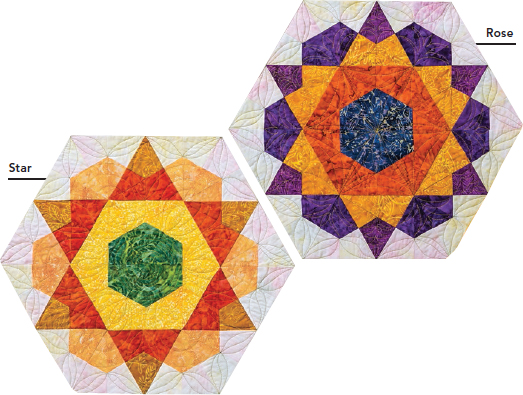
Flower is transparent: To make the flower appear to float over the star, select E as one color, D another color, and C to be a mix of those colors together.
Hexagons are transparent: To make a ring of hexagons appear to be see-through over the star, make choices like the previous design and choose B to be a variation of E and C. The center A can be of its own color/value or it can match D to give the illusion of 6 hexagons with a hole in the middle lying over a star.

MATERIALS
Yardage is based on 42-wide fabric.
Fabric: yard each of 2530 fabrics for AE (Precut 2 strips work well, too.)
Background: 1 yards
Backing: 2 yards
Binding: yard
Batting: 50 54
60 ruler: Clearview Triangle 60 Acrylic Ruler (any size) or Clearview Triangle Super 60 Acrylic Ruler (from C&T Publishing)
tip
Because there are so many fabrics involved, make a swatch card to stay organized.
CUTTING
WOF = width of fabric
CUTTING FOR EACH BLOCK:
Each section, AE, uses only a portion of a strip that is 2 WOF. The fraction used is listed here. The background fabric uses slightly more than a full strip.
A: strip 2 WOF
B: strip 2 WOF
C: strip 2 WOF
D: strip 2 WOF
E: strip 2 WOF
Background: 1 strips 2 WOF
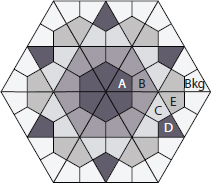
Making Teardrops
The teardrops are cut from rectangles of fabric. To save time, some of the rectangles are sewn together before cutting. Cut rectangles 2 4. Cutting EdgeRepositionable Vinyl Ruler Stops (from C&T Publishing) are handy for cutting these. Cut the following quantities per flower:
A: 3 rectanglesLeave unsewn.
B: 6 rectanglesSew together, following the instructions below.
C: 6 rectanglesSew together, following the instructions below.
D: 3 rectanglesLeave unsewn.
E: 6 rectanglesLeave unsewn.
Background: 12 rectanglesSew together, following the instructions below.
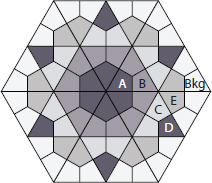
Sewing Rectangles
Use seam allowances.
For B, C, and the background, sew pairs of rectangles of the same fabric, right sides together, along both short ends.
Next page
